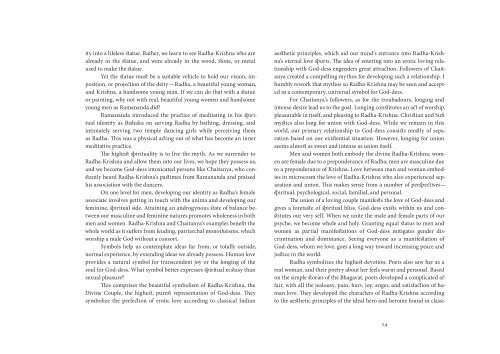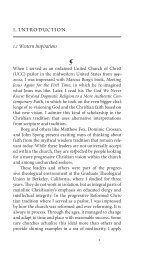The Way of Natural Devotion - Universalist Radha-Krishnaism
The Way of Natural Devotion - Universalist Radha-Krishnaism
The Way of Natural Devotion - Universalist Radha-Krishnaism
Create successful ePaper yourself
Turn your PDF publications into a flip-book with our unique Google optimized e-Paper software.
ity into a lifeless statue. Rather, we learn to see <strong>Radha</strong>-Krishna who are<br />
already in the statue, and were already in the wood, stone, or metal<br />
used to make the statue.<br />
Yet the statue must be a suitable vehicle to hold our vision, imposition,<br />
or projection <strong>of</strong> the deity—<strong>Radha</strong>, a beautiful young woman,<br />
and Krishna, a handsome young man. If we can do that with a statue<br />
or painting, why not with real, beautiful young women and handsome<br />
young men as Ramananda did?<br />
Ramananda introduced the practice <strong>of</strong> meditating in his spiritual<br />
identity as Bishaka on serving <strong>Radha</strong> by bathing, dressing, and<br />
intimately serving two temple dancing girls while perceiving them<br />
as <strong>Radha</strong>. This was a physical acting out <strong>of</strong> what has become an inner<br />
meditative practice.<br />
<strong>The</strong> highest spirituality is to live the myth. As we surrender to<br />
<strong>Radha</strong>-Krishna and allow them into our lives, we hope they possess us,<br />
and we become God-dess intoxicated persons like Chaitanya, who constantly<br />
heard <strong>Radha</strong>-Krishna’s pastimes from Ramananda and praised<br />
his association with the dancers.<br />
On one level for men, developing our identity as <strong>Radha</strong>’s female<br />
associate involves getting in touch with the anima and developing our<br />
feminine, spiritual side. Attaining an androgynous state <strong>of</strong> balance between<br />
our masculine and feminine natures promotes wholeness in both<br />
men and women. <strong>Radha</strong>-Krishna and Chaitanya’s examples benefit the<br />
whole world as it suffers from feuding, patriarchal monotheisms, which<br />
worship a male God without a consort.<br />
Symbols help us contemplate ideas far from, or totally outside,<br />
normal experience, by extending ideas we already possess. Human love<br />
provides a natural symbol for transcendent joy or the longing <strong>of</strong> the<br />
soul for God-dess. What symbol better expresses spiritual ecstasy than<br />
sexual pleasure?<br />
This comprises the beautiful symbolism <strong>of</strong> <strong>Radha</strong>-Krishna, the<br />
Divine Couple, the highest, purest representation <strong>of</strong> God-dess. <strong>The</strong>y<br />
symbolize the perfection <strong>of</strong> erotic love according to classical Indian<br />
aesthetic principles, which aid our mind’s entrance into <strong>Radha</strong>-Krishna’s<br />
eternal love sports. <strong>The</strong> idea <strong>of</strong> entering into an erotic loving relationship<br />
with God-dess engenders great attraction. Followers <strong>of</strong> Chaitanya<br />
created a compelling mythos for developing such a relationship. I<br />
humbly rework that mythos so <strong>Radha</strong>-Krishna may be seen and accepted<br />
as a contemporary, universal symbol for God-dess.<br />
For Chaitanya’s followers, as for the troubadours, longing and<br />
intense desire lead us to the goal. Longing constitutes an act <strong>of</strong> worship,<br />
pleasurable in itself, and pleasing to <strong>Radha</strong>-Krishna. Christian and Sufi<br />
mystics also long for union with God-dess. While we remain in this<br />
world, our primary relationship to God-dess consists mostly <strong>of</strong> separation<br />
based on our existential situation. However, longing for union<br />
seems almost as sweet and intense as union itself.<br />
Men and women both embody the divine <strong>Radha</strong>-Krishna: women<br />
are female due to a preponderance <strong>of</strong> <strong>Radha</strong>; men are masculine due<br />
to a preponderance <strong>of</strong> Krishna. Love between man and woman embodies<br />
in microcosm the love <strong>of</strong> <strong>Radha</strong>-Krishna who also experienced separation<br />
and union. This makes sense from a number <strong>of</strong> perspectives—<br />
spiritual, psychological, social, familial, and personal.<br />
<strong>The</strong> union <strong>of</strong> a loving couple manifests the love <strong>of</strong> God-dess and<br />
gives a foretaste <strong>of</strong> spiritual bliss. God-dess exists within us and constitutes<br />
our very self. When we unite the male and female parts <strong>of</strong> our<br />
psyche, we become whole and holy. Granting equal status to men and<br />
women as partial manifestations <strong>of</strong> God-dess mitigates gender discrimination<br />
and dominance. Seeing everyone as a manifestation <strong>of</strong><br />
God-dess, whom we love, goes a long way toward increasing peace and<br />
justice in the world.<br />
<strong>Radha</strong> symbolizes the highest devotion. Poets also saw her as a<br />
real woman, and their poetry about her feels warm and personal. Based<br />
on the simple stories <strong>of</strong> the Bhagavat, poets developed a complicated affair,<br />
with all the jealousy, pain, hurt, joy, anger, and satisfaction <strong>of</strong> human<br />
love. <strong>The</strong>y developed the characters <strong>of</strong> <strong>Radha</strong>-Krishna according<br />
to the aesthetic principles <strong>of</strong> the ideal hero and heroine found in classi-<br />
14







